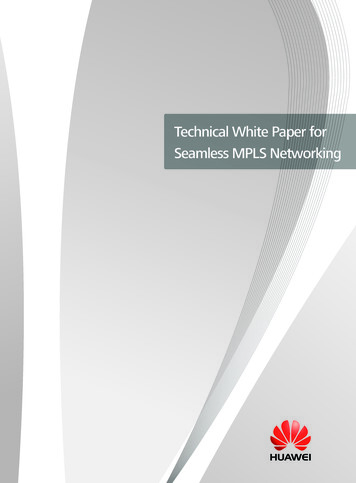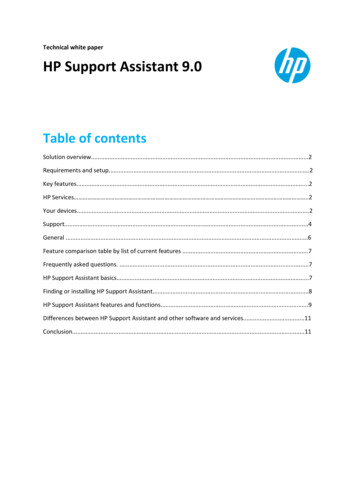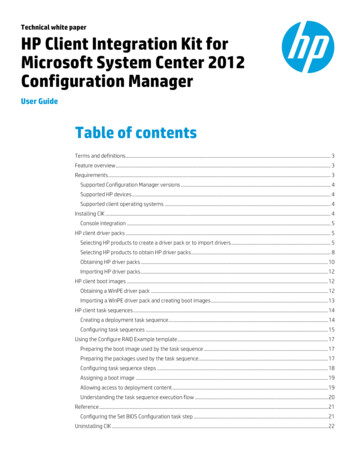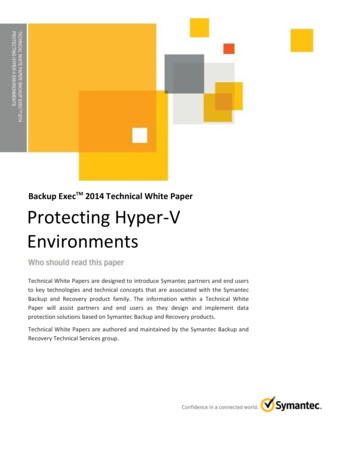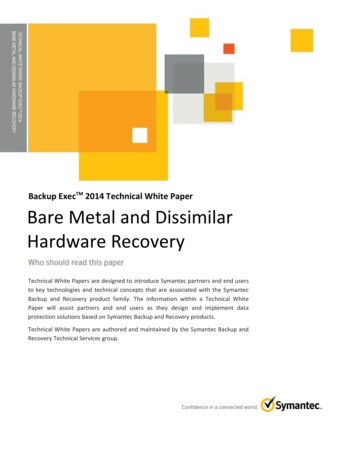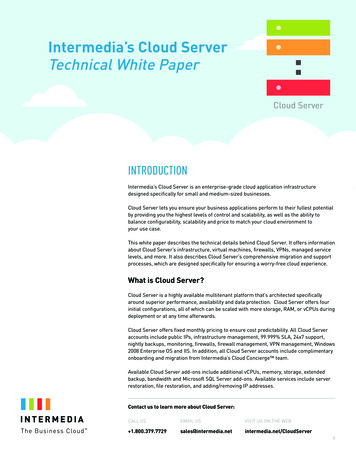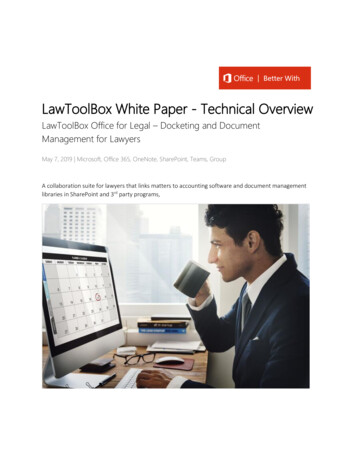
Transcription
Vo5G Technical White PaperDateJuly, 2018HUAWEI TECHNOLOGIES CO., LTD.
Copyright Huawei Technologies Co., Ltd. 2018. All rights reserved.No part of this document may be reproduced or transmitted in any form or by any means withoutprior written consent of Huawei Technologies Co., Ltd.Trademarks and Permissionsand other Huawei trademarks are trademarks of Huawei Technologies Co., Ltd. All othertrademarks and trade names mentioned in this document are the property of their respectiveholders.NoticeThis document may contain forecasting information, including but not limited to informationabout future financials, operations, product lines, new technologies, and more. Because there aremany uncertainties in practice, the actual results may differ greatly from the forecast information.Therefore, the information in this document is for informational purposes only and does notconstitute an offer or promise. Huawei may modify the above information without notice withoutprior notice.Huawei Technologies Co., Ltd.Address:Huawei Industrial Base, Bantian, Longgang, Shenzhen 518129People's Republic of ChinaWebsite:http://www.huawei.com1
Vo5G Technical White PaperContents1 Introduction . 52 Vo5G Has Been Standardized Together with 5G . 52.1 What Is Vo5G? . 52.2 Vo5G Standard Development . 72.3 Voice and Video Codec Standard Development . 72.4 Introduction to the Vo5G Voice/Video Communication Solution . 82.4.1 VoNR . 82.4.2 EPS FB. 92.4.3 VoeLTE. 112.4.4 RAT FB . 112.5 Introduction to the Vo5G SMS and USSD Solutions . 132.6 Vo5G Solution on Different 5G Networks . 132.6.1 Introducing 5G by EPC NSA .132.6.2 Introducing 5G by 5GC .153 Vo5G Is an Important Technology for Accelerating 5G Development . 194 Road to Vo5G: IMS Readiness Is the Prerequisite . 205 Road to Vo5G: Accelerating VoLTE Commercialization Is the Basis. 215.1 Voice Solution Selected at the Initial Stage of 5G Commercialization . 215.2 Evolution to VoNR. 225.2.2 Path1: VoLTE- EPS FB- VoNR .235.2.3 Path2: VoLTE- VoNR .235.2.4 Path3:VoLTE- VoeLTE- RAT FB- VoNR .235.3 Accelerating VoLTE as the Fundamental Network of Vo5G . 242
Vo5G Technical White Paper6 After Vo5G: Industry-oriented Real-Time Voice and Video CommunicationEvolves Continuously . 256.1 5G Will Bring New Changes to Carriers' Real-Time Voice and VideoCommunication . 256.2 3GPP Release 16 Has Initiated a Research on the Next-Generation Real-TimeCommunications Networks. 257 Conclusion . 268 Glossary . 273
Vo5G Technical White PaperFiguresFigure 2-1 5G Voice Solution Options. 6Figure 2-2 Vo5G Standard Development . 7Figure 2-3 VoNR Protocol Stack via 5GC and gNB . 8Figure 2-4 VoNR Protocol Stack via EPC and gNB . 9Figure 2-5 EPS Fallback Protocol Stack .10Figure 2-6 VoeLTE Protocol Stack .11Figure 2-7 RAT Fallback Protocol Stack .12Figure 2-8 5G option 3/3a/3X Networking .13Figure 2-9 VoLTE over E-UTRA PDCP Protocol Stack .14Figure 2-10 VoLTE over NR PDCP Protocol Stack .14Figure 2-11 5G Option7/7a/7X Networking .15Figure 2-12 5G Option5 Networking .16Figure 2-13 5G Option2 Networking .16Figure 2-14 Evolution from EPS Fallback to VoNR .17Figure 2-15 Evolution from VoLTE of dual registration to VoNR .17Figure 2-16 Evolution from RAT Fallback to VoNR .18Figure 2-17 5G Option4/4a Networking .18Figure 5-1 Selection of 5G Deployment Options .22Figure 5-2 Selection of 5G Voice Solutions.22Figure 5-3 Evolution to VoNR .234
Vo5G Technical White Paper1IntroductionOn June 14, 2018, 3GPP TSG #80 Plenary Meeting approved the completion of5G NR specifications for standalone (SA). In addition, after the release of the5G NR specifications for non-standalone (NSA) in December 2017,standardization of 5G at the first stage has been successfully completed. Thismeans that 5G standards are completed on time and 5G networks will be putinto commercial use.Although data services drive 5G evolution, voice/video communicationservices are still important services of carriers. Like 4G networks, how to providevoice/video communication services must be first determined for 5Gcommercialization.2Vo5G Has Been Standardized Togetherwith 5G2.1 What Is Vo5G?3GPP has specified that 5G uses the 4G voice/video communicationarchitecture and still provides voice/ video communication services based onthe IMS. The 4G radio access technology is LTE, and the voice/video over theLTE network is called VoLTE. The 5G radio access technology is NR, and the5
Vo5G Technical White Papervoice/video over the 5G network is called voice/video over NR (VoNR). VoLTEand VoNR are different access modes for IMS voice/video communicationservices.In the 4G voice solution, VoLTE is the target voice/video communicationsolution for 4G networks. With the expansion of 4G network coverage andmaturity of the terminal ecosystem considered, global carriers haveexperienced the evolution from CSFB to VoLTE.In addition to the expansion of 5G network coverage and maturity of theterminal ecosystem, carriers need to consider the factors of various 5Gnetwork deployment options when deploying 5G networks. The 5Gvoice/video communication solution faces the options and evolution processshown in the following figure.Figure 2-1 5G Voice Solution OptionsAs shown in the preceding figure, in addition to VoNR, the voice/videocommunication solutions EPS fallback (EPS FB), RAT fallback (RAT FB), andvoice/video over eLTE (VoeLTE) (Note 1) need to be implemented by using the5G core network (5GC). These solutions are not defined in the 4G era.Therefore, VoNR cannot represent all 5G voice/video communicationsolutions. The industry needs to use Vo5G to summarize all 5G voice/videocommunication solutions. Vo5G should include VoNR, VoeLTE, EPS FB, and RATFB.Note1: eLTE, which is also called ng-eNB, supports the access to the 5GC aftera 4G base station is upgraded. For details about the definition of the eLTEarchitecture, see 3GPP TS 38.300.6
Vo5G Technical White Paper2.2 Vo5G Standard DevelopmentAt the beginning of 5G standardization, voice/video communication serviceshave been fully considered. By June 2018, 3GPP has completed the definitionof basic Vo5G functions in Release 15, meeting the requirements ofcommercial deployment of 5G networks.Figure 2-2 Vo5G Standard DevelopmentThere are many options for 5G networking. The voice/video communicationsolution has been standardized regardless of whether 5G is introduced by EPCNSA or is introduced by 5GC. After the 5GC is introduced, the 5GC does notprovide the CSFB solution to simplify the network and accelerate the exit ofthe CS voice.2.3 Voice and Video Codec Standard DevelopmentAccording to GSMA and 3GPP, EVS (Note 2) and H.265 are mandatory codecfor voice and video communication services in Vo5G. Compared with VoLTEAMR and H.264, EVS and H.265 require fewer bandwidths to provide betteruser experience.In the future, 3GPP will complete the standardization of Immersive Voice andAudio Services (IVAS) in Release 16. IVAS provides better user experience andhigher error robustness under various transmission conditions from cleanchannels to channels with packet loss and delay jitter. IVAS provides supportfor a range of service capabilities, e.g., from mono to stereo to fully immersiveaudio encoding/decoding/rendering.At the same time, ITU and ISO have set up a joint research team, which isstudying the next-generation video codec standard H.266. A new generationof video standards will be released in 2020. Currently, with the technologiesaccumulated in the industry, H.266 has improved the performance by over 40%compared with H.265. H.266 will be the most advanced video compressiontechnology solution in the industry.7
Vo5G Technical White PaperWith the continuous evolution of the voice and video codec, IVAS and H.266are expected to take the lead in Vo5G, continuously improving userexperience.Note 2: Enhanced Voice Services (EVS) is standardized in 3GPP Release 12and is the voice codec providing high error robustness and good voice qualityat present.2.4 Introduction to the Vo5G Voice/VideoCommunication Solution2.4.1 VoNRVoNR indicates that the voice/video communication service is carried on thegNB. There are two options based on different 5G networks:1. The 5GC and gNB are used to carry VoNR, as shown in the following cHTTP/XCAPRTP/RTCPTCP/IP – UDP/IPSIPTCP/IP – UDP/IPNR PDCPNR PDCPNR RLCNR RLCNR MACNR MACNR PHYNR PHYUEHTTP/XCAPCodecRTP/RTCPTCP/IP – UDP/IPQoS FlowgNB and 5GCIMSFigure 2-3 VoNR Protocol Stack via 5GC and gNB2. The EPC and gNB are used to carry VoNR, as shown in the following figure.8
Vo5G Technical White TTP/XCAPRTP/RTCPTCP/IP – UDP/IPSIPTCP/IP – UDP/IPNR PDCPNR PDCPNR RLCNR RLCNR MACNR MACNR PHYNR PHYUEHTTP/XCAPCodecRTP/RTCPTCP/IP – UDP/IPEPS bearergNB and EPCIMSFigure 2-4 VoNR Protocol Stack via EPC and gNBIn VoNR, UEs camp on the NR network, and voice/video communication anddata services are carried on the NR network. When a UE moves to the areawhere the NR signal coverage is poor, a coverage-based handover needs tobe initiated to implement the interworking with the 4G network. Then, the UEhandovers to the LTE network, and the VoLTE service is provided.2.4.2 EPS FBThe description of EPS FB is as follows:The 5G NR network does not provide voice/video communication services atthe initial stage. When the gNB establishes an IMS voice/video communicationchannel on the NR network, a handover is triggered. In this case, the gNBsends a redirection or inter-RAT handover request to the 5GC to fall back tothe LTE network and use the VoLTE service, as shown in the following figure.9
Vo5G Technical White PaperVoice/Video ServiceVoice/Video ServiceSIPSIPHTTP/XCAPTCP/IP – UDP/IPTCP/IP – UDP/IPNR PDCPNR PDCPNR RLCNR RLCNR MACNR MACNR PHYN
Vo5G Technical White Paper 6 voice/video over the 5G network is called voice/video over NR (VoNR). VoLTE and VoNR are different access modes for IMS voice/video communication services. In the 4G voice solution, VoLTE is the target voice/video communication solution for 4G networks. With the expansion of 4G network coverage and maturity of the terminal ecosystem considered, global carriers File Size: 824KBPage Count: 29
